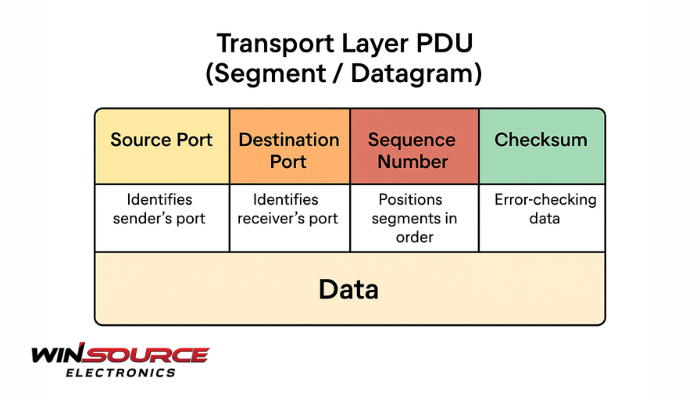
* Question
What fields are included in the Transport Layer PDU (Protocol Data Unit), and what are their functions?
* Answer
In the OSI (Open Systems Interconnection) model, the transport layer is responsible for reliable data delivery, segmentation, and flow control between end systems. Its Protocol Data Unit (PDU) is commonly referred to as a segment (in TCP) or a datagram (in UDP). Each transport layer PDU consists of several fields that ensure accurate, ordered, and error-free communication between networked devices.
1. Source Port and Destination Port
These fields identify the sending and receiving applications on host systems.
Source Port: Indicates the port number of the process initiating the communication.
Destination Port: Specifies the target process on the receiving end.
Together, they enable multiplexing, allowing multiple applications to share the same network connection simultaneously.
2. Sequence Number
Used primarily in TCP, the sequence number ensures data segmentation order. It helps the receiver reconstruct the original data stream by arranging received segments in the correct order, even if packets arrive out of sequence.
3. Acknowledgment Number
Also unique to TCP, this field provides feedback to the sender by confirming the next expected byte. It’s the cornerstone of reliable transmission and enables the ACK (acknowledgment) mechanism that prevents data loss.
4. Header Length and Control Flags
The header length indicates where the data section begins, helping parsers interpret the PDU structure correctly.
Control flags (such as SYN, ACK, FIN, PSH, RST, URG) control connection establishment, termination, and flow operations. These flags enable connection-oriented services, making TCP a reliable protocol.
5. Window Size
This field defines the amount of data that can be sent before waiting for an acknowledgment. It’s a vital component of flow control, helping optimize network performance and avoid congestion.
6. Checksum
The checksum ensures data integrity by verifying whether the segment was altered during transmission. Both TCP and UDP use this field to detect errors in the header and data sections.
7. Urgent Pointer (Optional)
When the URG flag is set, the urgent pointer identifies data that should be prioritized for immediate processing. This field is rarely used in modern applications but remains part of the TCP header definition.
8. Options and Padding
The options field allows flexibility for additional features, such as timestamping or selective acknowledgments (SACK). Padding ensures that the header ends on a 32-bit boundary for alignment purposes.
Summary
Each transport layer PDU—whether a TCP segment or a UDP datagram—contains structured fields that define how data is transmitted, verified, and reassembled.
TCP emphasizes reliability, order, and control through extensive header fields.
UDP provides simplicity and low latency by using fewer fields.
Understanding these structures helps engineers optimize network performance, troubleshoot connectivity issues, and design robust communication protocols in embedded systems, IoT devices, and industrial networks.

COMMENTS